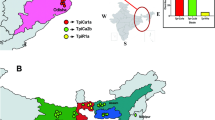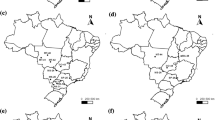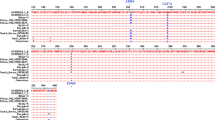Abstract
The fall armyworm (FAW), Spodoptera frugiperda invaded China in December 2018 and has since spread quickly countrywide. Two sympatric biotype strains of FAW, rice-strain and corn-strain, have been classified and showed to have different susceptibilities to chemical insecticides. Present FAW control has primarily relied on insecticides, which resulted in a rapid evolution of the resistance to insecticides in FAW. Herein, sixteen geographical populations of FAW were collected annually from maize fields in China between 2019 and 2021, both Tpi genotyping (n = 3079) and feeding preference bioassay (n = 2892) showed Chinese FAW were predominantly the corn-strain. Resistance monitoring revealed that FAW had not evolved resistance to chlorantraniliprole since it invaded China with RRs of 0.32–2.32 and a very low mutation frequency RyR of 0.14%. Most FAW populations were susceptible to emamectin benzoate, spinetoram, indoxacarb, lambda-cyhalothrin and acephate. However, low resistance levels (5 < RR < 10) were detected in some populations, suggesting rotational or mixed applications of insecticides and further resistance monitoring must be strengthened to prevent or delay the development of insecticide resistance. The mutation frequency of ace-1 at the locus A201S and F290V was 21.27% and 84.51%, respectively. The mutation frequency of VGSC at the locus T929I and L1014F was 0.11% and 0.15%, respectively. The detoxification enzyme activities of P450s, ESTs and GSTs were relatively consistent among different populations. Our study provides a systematical understanding of the current genetic architecture and resistance status of FAW in China and will contribute to the region-wide chemical control and the development of resistance management strategies for FAW in China.




Similar content being viewed by others
Availability of data and materials
The data presented in this study are available in Supplementary Materials.
References
Abbott WS (1925) A method of computing the effectiveness of an insecticide. J Econ Entomol 18:265–267. https://doi.org/10.1093/jee/18.2.265a
Adamczyk JR, Holloway JW, Leonard BR, Graves JB (1997) Susceptibility of fall armyworm collected from different plant hosts to selected insecticides and transgenic Bt cotton. J Cotton Sci 1:21–28. https://doi.org/10.3958/059.037.0304
Ashley TR, Wiseman BR, Davis FM, Andrews KL (1989) The fall armyworm: a bibliography. Fla Entomol 72:152–202. https://doi.org/10.2307/3494982
Asperen KV (1962) A study of housefly esterases by means of a sensitive colorimetric method. J Ins Physiol 8:401–416. https://doi.org/10.1016/0022-1910(62)90074-4
Barros EM, Torres JB, Ruberson JR, Oliveira MD (2010) Development of Spodoptera frugiperda on different hosts and damage to reproductive structures in cotton. Entomol Exp Appl 137:237–245. https://doi.org/10.1111/j.1570-7458.2010.01058.x
Boaventura D, Bolzan A, Padovez FEO, Okuma DM, Omoto C, Nauen R (2020a) Detection of a ryanodine receptor target-site mutation in diamide insecticide resistant fall armyworm, Spodoptera frugiperda. Pest Manag Sci 76:47–54. https://doi.org/10.1002/ps.5505
Boaventura D, Martin M, Pozzebon A, Mota-sanchez D, Nauen R (2020b) Monitoring of target-site mutations conferring insecticide resistance in Spodoptera frugiperda. Insects 11:545. https://doi.org/10.3390/insects11080545
Bradford MM (1976) A rapid and sensitive method for the quantitation of microgram quantities of protein utilizing the principle of protein-dye binding. Anal Biochem 72:248–254. https://doi.org/10.1016/0003-2697(76)90527-3
Carvalho RA, Omoto C, Field LM, Williamson MS, Bass C (2013) Investigating the molecular mechanisms of organophosphate and pyrethroid resistance in the fall armyworm Spodoptera frugiperda. PLoS ONE 8:e62268. https://doi.org/10.1371/journal.pone.0062268
Chen X, Palli SR (2022) Transgenic overexpression of P450 genes confers deltamethrin resistance in the fall armyworm, Spodoptera frugiperda. J Pest Sci 95:1197–1205. https://doi.org/10.1007/s10340-021-01452-6
Dumas P, Legeai F, Lemaitre C, Scaon E, Orsucci M, Labadie K, Gimenez S, Clamens AL, Henri H, Vavre F, Aury JM, Fournier P, Kergoat GJ, d’Alençon E (2015) Spodoptera frugiperda (Lepidoptera: Noctuidae) host-plant variants: two host strains or two distinct species? Genetica 143:305–316. https://doi.org/10.1007/s10709-015-9829-2
Finney DJ (1971) Probit analysis. Cambridge University, London, pp 68–78
Gimenez S, Abdelgaffar H, Goff GL, Hilliou F, Blanco CA, Hänniger S, Bretaudeau A, Legeai F, Nègre N, Jurat-Fuentes JL, d’Alençon E, Nam K (2020) Adaptation by copy number variation increases insecticide resistance in the fall armyworm. Commun Biol 3:664. https://doi.org/10.1038/s42003-020-01382-6
Guan F, Zhang JP, Shen HW, Wang XL, Padovan A, Walsh TK, Tay WT, Gordon KHJ, James W, Czepak C, Otim MH, Kachigamba D, Wu YD (2021) Whole-genome sequencing to detect mutations associated with resistance to insecticides and Bt proteins in Spodoptera frugiperda. Insect Sci 28:627–638. https://doi.org/10.1111/1744-7917.12838
Guo ZM, Deng XQ, Li J, Yuan MJ, Wan H, Li JH, Ma KS (2020) Detection of insecticide sensitivity and target site mutations in field populations of Spodoptera frugiperda (Lepidoptera: Noctuidae) in four regions of Hubei, Central China. Acta Entomol Sin 63:582–589. https://doi.org/10.16380/j.kcxb.2020.05.007
Gutiérrez-Moreno R, Mota-Sanchez D, Blanco CA, Whalon ME, Terán-Santofimio H, Rodriguez-Maciel JC, DiFonzo C (2019) Field-evolved resistance of the fall armyworm (Lepidoptera: Noctuidae) to synthetic insecticides in Puerto Rico and Mexico. J Econ Entomol 112:792–802. https://doi.org/10.1093/jee/toy372
Habig WH, Pabst MJ, Jakoby WB (1974) Glutathione S-transferases. The first enzymatic step in mercapturic acid formation. J Biol Chem 249:7130–7139. https://doi.org/10.1016/S0021-9258(19)42083-8
Hardke JT, Lorenz GM, Leonard BR (2015) Fall armyworm (Lepidoptera: Noctuidae) ecology in southeastern cotton. J Integr Pest Manag 6:10. https://doi.org/10.1093/jipm/pmv009
Herrera-Mayorga EV, Bello-Ruiz DG, Paredes-Sánchez FA, Segovia-Tagle V, García-Aguirre KK, Lara-Ramírez EE, Rivera G (2018) Identification of snp´s in the ace-1 gene of Spodoptera frugiperda associated with resistance to organophosphorus insecticides. Southwest Entomol 43:855–865. https://doi.org/10.3958/059.043.0404
Huang Q, Ling Y, Jiang T, Fu CQ, Zhong Y, Wu BQ, Huang SS, Li C, Huang FK, Long LP (2020) Prediction of the generations of Spodoptera frugiperda in Guangxi by using the law of effective temperature. J South Agric 51:1282–1286. https://doi.org/10.3969/j.issn.2095-1191.2020.06.005
Jing DP, Guo JF, Jiang YY, Zhao JZ, Sethi A, He KL, Wang ZY (2020) Initial detections and spread of invasive Spodoptera frugiperda in China and comparisons with other noctuid larvae in cornfields using molecular techniques. Insect Sci 27:780–790. https://doi.org/10.1111/1744-7917.12700
Kergoat GJ, Prowell DP, Ru BPL, Mitchell A, Dumas P, Clamens AL, Condamine FL, Silvan JF (2012) Disentangling dispersal, vicariance and adaptive radiation patterns: a case study using armyworms in the pest genus Spodoptera (Lepidoptera: Noctuidae). Mol Phylogenet Evol 65:855–870. https://doi.org/10.1016/j.ympev.2012.08.006
Kwon DH, Yoon KS, Clark JM, Lee SH (2010) A point mutation in a glutamate-gated chloride channel confers abamectin resistance in the two-spotted spider mite, Tetranychus urticae Koch. Insect Mol Biol 19:583–591. https://doi.org/10.1111/j.1365-2583.2010.01017.x
Leora Software (1987) POLO-PC: a user’s guide to probit or logit analysis. Leora Software, Berkeley
Li XC, Schuler MA, Berenbaum MR (2007) Molecular mechanisms of metabolic resistance to synthetic and natural xenobiotics. Annu Rev Entomol 52:231–253. https://doi.org/10.1146/annurev.ento.51.110104.151104
Li XJ, Wu MF, Ma J, Gao BY, Wu QL, Chen AD, Liu J, Jiang YY, Zhai BP, Early R, Chapman JW, Hu G (2019a) Prediction of migratory routes of the invasive fall armyworm in eastern China using a trajectory analytical approach. Pest Manag Sci 76:454–463. https://doi.org/10.1101/625632
Li YP, Zhang S, Wang XJ, Xie XP, Liang P, Zhang L, Gu SH, Gao XW (2019b) Current status of insecticide resistance in Spodoptera frugiperda and strategies for its chemical control. Plant Prot 45:14–19. https://doi.org/10.16688/j.zwbh.2019315
Li Y, Gong LF, Wang HH, Li X, Sun G, Gu SH, Liang P, Gao XW (2020) Genotype and mutation frequency of ace-1, the target gene of organophosphorus and carbamate insecticides, in field populations of Spodoptera frugiperda (Lepidoptera: Noctuidae) in China. Acta Entomol Sin 63:574–581. https://doi.org/10.16380/j.kcxb.2020.05.006
Li YH, Wang ZY, Romeis J (2021) Managing the invasive fall armyworm through biotech crops: a Chinese perspective. Trends Biotechnol 39:105–107. https://doi.org/10.1016/j.tibtech.2020.07.001
Liang GM, Tan WJ, Guo YY (1999) An improvement in the technique of artificial rearing cotton bollworm. Plant Prot 25:15–17
Lima ER, McNeil JN (2009) Female sex pheromones in the host races and hybrids of the fall armyworm, Spodoptera frugiperda (Lepidoptera: Noctuidae). Chemoecology 19:29–36. https://doi.org/10.1007/s00049-009-0005-y
Lv SL, Wang YB, Gu SH, Liang P, Zhang L, Gao XW (2020) Comparison of bioassay methods for the toxicities of chemical insecticides against Spodoptera frugiperda (Lepidoptera: Noctuidae). Acta Entomol Sin 63:590–596. https://doi.org/10.16380/j.kcxb.2020.05.008
Ministry of Agriculture of the People’s Republic of China (2006) Pesticides guideline for laboratory bioactivity tests Part 1: The topical application test for insecticide contact activity. China Agriculture Press, Beijing
Montezano DG, Specht A, Sosa-Gómez DR, Roque-Specht VF, Sousa-Silva JC, Paula-Moraes SV, Peterson JA, Hunt TE (2018) Host plants of Spodoptera frugiperda (Lepidoptera: Noctuidae) in the Americas. Afr Entomol 26:286–300. https://doi.org/10.4001/003.026.0286
Nagoshi RN (2010) The fall armyworm Triose phosphate isomerase (Tpi) gene as a marker of strain identity and interstrain mating. Ann Entomol Soc Am 103:283–292. https://doi.org/10.1603/an09046
Nagoshi RN (2012) Improvements in the identification of strains facilitate population studies of fall armyworm subgroups. Ann Entomol Soc Am 105:351–358. https://doi.org/10.1603/AN11138
Nagoshi RN, Meagher RL (2016) Using intron sequence comparisons in the triosephosphate isomerase gene to study the divergence of the fall armyworm host strains. Insect Mol Biol 25:324–337. https://doi.org/10.1111/imb.12223
Nagoshi RN, Meagher RL, Nuessly G, Hall DG (2006) Effects of fall armyworm (Lepidoptera: Noctuidae) interstrain mating in wild populations. Environ Entomol 35:561–568. https://doi.org/10.1603/0046-225X-35.2.561
Nagoshi RN, Koffi D, Agboka K, Tounou KA, Banerjee R, Jurat-Fuentes JL, Meagher RL (2017) Comparative molecular analyses of invasive fall armyworm in Togo reveal strong similarities to populations from the eastern United States and the Greater Antilles. PLoS ONE 12:e0181982. https://doi.org/10.1371/journal.pone.0181982
National Agro-Technical Extension and Service Center (2021) Nation resistance monitoring report in agricultural pests in 2020 and recommendations on chemical control. Chin Plant Prot 41:71–78
Paredes-Sánchez FA, Rivera G, Bocanegra-García V, Martínez-Padrón HY, Berrones-Morales M, Niño-García N, Herrera-Mayorga V (2021) Advances in control strategies against Spodoptera frugiperda. A review. Molecules 26:5587. https://doi.org/10.3390/molecules26185587
Pashley DP, Martin JA (1987) Reproductive incompatibility between host strains of the fall armyworm (Lepidoptera: Noctuidae). Ann Entomol Soc Am 80:731–733. https://doi.org/10.1093/aesa/80.6.731
Ríos-Díez JD, Siegfried B, Saldamando-Benjumea CI (2012) Susceptibility of Spodoptera frugiperda (Lepidoptera: Noctuidae) strains from central Colombia to Cry1Ab and Cry1Ac entotoxins of Bacillus thuringiensis. Southwest Entomol 37:281–293. https://doi.org/10.3958/059.037.0304
Rose RL, Barbhaiya L, Roe RM, Rock GC, Hodgson E (1995) Cytochrome P450-associated insecticide resistance and the development of biochemical diagnostic assays in Heliothis virescens. Pestic Biochem Physiol 51:178–191. https://doi.org/10.1006/pest.1995.1018
Silva WM, Berger M, Bass C, Williamson M, Moura DMN, Ribeiro LMS, Siqueira HAA (2016) Mutation (G275E) of the nicotinic acetylcholine receptor α6 subunit is associated with high levels of resistance to spinosyns in Tuta absoluta (Meyrick) (Lepidoptera: Gelechiidae). Pestic Biochem Physiol 131:1–8. https://doi.org/10.1016/j.pestbp.2016.02.006
Song YF, Wu KM (2020) Investigation on controlling status of fall armyworm in sweet/waxy corn fields in western Yunnan province. Plant Prot 46:217–222. https://doi.org/10.16688/j.zwbh.2020175
Sparks AN (1979) A review of the biology of the fall armyworm. Fla Entomol 62:82–87. https://doi.org/10.2307/3494083
Sparks TC, Crossthwaite AJ, Nauen R, Banba S, Cordova D, Earley F, Ebbinghaus-Kintscher U, Fujioka S, Hirao A, Karmon D, Kennedy R, Nakao T, Popham HJR, Salgado V, Watson GB, Wedel BJ, Wessels FJ (2020) Insecticides, biologics and nematicides: updates to IRAC’s mode of action classification—a tool for resistance management. Pestic Biochem Physiol 167:104587. https://doi.org/10.1016/j.pestbp.2020.104587
Su H, Lv BQ, Zhang BQ, Lu H, Tang JH, Yang SY, Wu QQ (2021) Selective toxicity of twelve insecticides to Spodoptera frugiperda and Tetrastichus howardi (Olliff). J South Agric 52:570–577. https://doi.org/10.3969/j.issn.2095-1191.2021.03.003
Sun XX, Hu CX, Jia HR, Wu QL, Shen XJ, Zhao SY, Jiang YY, Wu KM (2021) Case study on the first immigration of fall armyworm, Spodoptera frugiperda invading into China. J Integr Agric 20:664–672. https://doi.org/10.1016/S2095-3119(19)62839-X
Wang XL, Wen S, Zhang JH, Yang YH, Dong K, Wu YD (2016a) Two novel sodium channel mutations associated with resistance to indoxacarb and metaflumizone in the diamondback moth, Plutella xylostella. Insect Sci 23:50–58. https://doi.org/10.1111/1744-7917.12226
Wang X, Wang R, Yang Y, Wu S, O’Reilly AO, Wu Y (2016b) A point mutation in the glutamate-gated chloride channel of Plutella xylostella is associated with resistance to abamectin. Insect Mol Biol 25:116–125. https://doi.org/10.1111/imb.12204
Wang J, Wang XL, Lansdell SJ, Zhang JH, Millar NS, Wu YD (2016c) A three amino acid deletion in the transmembrane domain of the nicotinic acetylcholine receptor α6 subunit confers high-level resistance to spinosad in Plutella xylostella. Insect Biochem Mol Biol 71:29–36. https://doi.org/10.1016/j.ibmb.2016.02.001
Wang HH, Lv SL, Zhao R, Liang P, Zhang S, Gao XW, Zhang L, Gu SH (2021) Establishment of susceptible baselines of Spodoptera frugiperda (Lepidoptera: Noctuidae) to commonly used insecticides. Acta Entomol Sin 64:1427–1432. https://doi.org/10.16380/j.kcxb.2021.12.008
Westbrook JK, Nagoshi RN, Meagher RL, Fleischer SJ, Jairam S (2016) Modeling seasonal migration of fall armyworm moths. Int J Biometeorol 60:255–267. https://doi.org/10.1007/s00484-015-1022-x
Wu KM (2020) Management strategies of fall armyworm (Spodoptera frugiperda) in China. Plant Prot 46:1–5. https://doi.org/10.16688/j.zwbh.2020088
Wu YD, Shen HW, Zhang Z, Wang XL, Shi Y, Wu SW, Yang YH (2019) Current status of insecticide resistance in Spodoptera frugiperda and counter measures to prevent its development. Chin J Appl Entomol 56:599–604. https://doi.org/10.7679/j.issn.2095-1353.2019.070
Xi JH, Pan YO, Bi R, Gao XW, Chen XW, Peng TF, Zhang M, Zhang H, Hu XY, Shang QL (2015) Elevated expression of esterase and cytochrome p450 are related with lambda–cyhalothrin resistance and lead to cross resistance in Aphis glycines Matsumura. Pestic Biochem Physiol 118:77–81. https://doi.org/10.1016/j.pestbp.2014.12.002
Xie DJ, Tang JH, Zhang L, Cheng YX, Jiang XF (2021) Annual generation numbers prediction and division of fall armyworm Spodoptera frugiperda in China. Plant Prot 47:61–67. https://doi.org/10.16688/j.zwbh.2020213
Yainna S, Nègre N, Silvie PJ, Brévault T, Tay WT, Gordon K, d’Alençon E, Walsh T, Nam K (2021) Geographic monitoring of insecticide resistance mutations in native and invasive populations of the fall armyworm. Insects 12:468. https://doi.org/10.3390/insects12050468
Yao R, Zhao DD, Zhang S, Zhou LQ, Wang X, Gao CF, Wu SF (2017) Monitoring and mechanisms of insecticide resistance in Chilo suppressalis (Lepidoptera: Crambidae), with special reference to diamides. Pest Manag Sci 73:1169–1178. https://doi.org/10.1002/ps.4439
Yasukochi Y, Ashakumary LA, Baba K, Yoshido A, Sahara K (2006) A second-generation integrated map of the silkworm reveals synteny and conserved gene order between lepidopteran insects. Genetics 173:1319–1328. https://doi.org/10.1534/genetics.106.055541
Yu SJ (1991) Insecticide resistance in the fall armyworm, Spodoptera frugiperda (J. E. Smith). Pestic Biochem Physiol 39:84–91. https://doi.org/10.1016/0048-3575(91)90216-9
Yu SJ, Nguyen SN, Abo-Elghar GE (2003) Biochemical characteristics of insecticide resistance in the fall armyworm, Spodoptera frugiperda (J. E. Smith). Pestic Biochem Physiol 77:1–11. https://doi.org/10.1016/S0048-3575(03)00079-8
Zhan EL, Wang Y, Jiang J, Jia ZQ, Tang T, Song ZJ, Han ZJ, Zhao CQ (2021) Influence of three insecticides targeting GABA receptor on fall armyworm Spodoptera frugiperda: Analyses from individual, biochemical and molecular levels. Pestic Biochem Physiol 179:104973. https://doi.org/10.1016/j.pestbp.2021.104973
Zhang L, Jin MH, Zhang DD, Jiang YY, Liu J, Wu KM, Xiao YT (2019a) Molecular identification of invasive fall armyworm Spodoptera frugiperda in Yunnan Province. Plant Prot 45:19–24. https://doi.org/10.16688/j.zwbh.2019121
Zhang L, Liu B, Jiang YY, Liu J, Wu KM, Xiao YT (2019b) Molecular identification of invasive fall armyworm Spodoptera frugiperda in China. Plant Prot 45:20–27. https://doi.org/10.16688/j.zwbh.2019296
Zhang BZ, Su X, Zhen CA, Lu LY, Li YS, Ge X, Chen DM, Pei Z, Shi MW, Chen XL (2020a) Silencing of cytochrome p450 in Spodoptera frugiperda (Lepidoptera: Noctuidae) by RNA interference enhances susceptibility to chlorantraniliprole. J Insect Sci 20:1–7. https://doi.org/10.1093/jisesa/ieaa047
Zhang L, Liu B, Zheng WG, Liu CH, Zhang DD, Zhao SY, Li ZY, Xu PJ, Wilson K, Withers A, Jones CM, Smith JA, Chipabika G, Kachigamba DL, Nam K, d’Alençon E, Liu B, Liang XY, Jin MH, Wu C, Chakrabarty S, Yang XM, Jiang YY, Liu J, Liu XL, Quan WP, Wang GR, Fan W, Qian WQ, Wu KM, Xiao YT (2020b) Genetic structure and insecticide resistance characteristics of fall armyworm populations invading China. Mol Ecol Resour 20:1682–1696
Zhao SY, Yang XM, Yang XL, Song YF, Wang WH, Wu KM (2019) Field efficacy of eight insecticides on fall armyworm, Spodoptera frugiperda. Plant Prot 45:74–78. https://doi.org/10.16688/j.zwbh.2019289
Zhao YX, Huang JM, Ni H, Guo D, Yang FX, Wang X, Wu SF, Gao CF (2020) Susceptibility of fall armyworm, Spodoptera frugiperda (J. E. Smith), to eight insecticides in China, with special reference to lambda-cyhalothrin. Pestic Biochem Physiol 168:104623. https://doi.org/10.1016/j.pestbp.2020.104623
Zhu YC, Blanco CA, Portilla M, Adamczyk J, Luttrell R, Huang FN (2015) Evidence of multiple/cross resistance to Bt and organophosphate insecticides in Puerto Rico population of the fall armyworm, Spodoptera frugiperda. Pestic Biochem Physiol 122:15–21. https://doi.org/10.1016/j.pestbp.2015.01.007
Acknowledgements
The authors are grateful to Ms. Xi Li and Ge Sun for rearing the insects.
Funding
This work was supported by National Key R&D Program of China (Grant No. 2021YFD1400700).
Author information
Authors and Affiliations
Contributions
SHG, HHW and RZ conceived the idea and wrote the manuscript. JG, LZ and SZ contributed to the data analysis. SHG, PL and XWG made critical editing and proofreading of the manuscript. HHW and RZ provided reagents and analytical tools. HHW and RZ performed the bioassays. All the authors read, corrected and approved the manuscript.
Corresponding author
Ethics declarations
Competing interests
The authors declare no conflict of interest.
Ethics approval and consent to participate
Not applicable.
Consent for publication
Not applicable.
Additional information
Communicated by Gaelle Le Goff.
Publisher's Note
Springer Nature remains neutral with regard to jurisdictional claims in published maps and institutional affiliations.
Supplementary Information
Below is the link to the electronic supplementary material.
Rights and permissions
Springer Nature or its licensor holds exclusive rights to this article under a publishing agreement with the author(s) or other rightsholder(s); author self-archiving of the accepted manuscript version of this article is solely governed by the terms of such publishing agreement and applicable law.
About this article
Cite this article
Wang, HH., Zhao, R., Gao, J. et al. Genetic architecture and insecticide resistance in Chinese populations of Spodoptera frugiperda. J Pest Sci 96, 1595–1610 (2023). https://doi.org/10.1007/s10340-022-01569-2
Received:
Revised:
Accepted:
Published:
Issue Date:
DOI: https://doi.org/10.1007/s10340-022-01569-2




